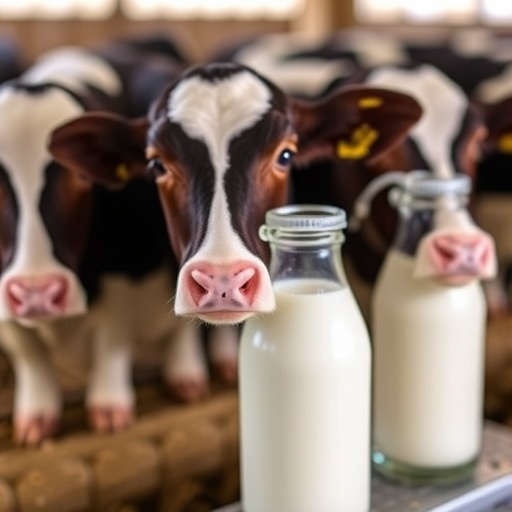In a groundbreaking study from St. Jude Children’s Research Hospital, scientists have addressed widespread concerns surrounding the presence of H5N1 influenza virus fragments in pasteurized milk circulating in the United States. As this strain of avian flu continues to impact the dairy cow population, the discovery of viral proteins and genetic material lingering in commercial milk sparked questions about potential health risks to consumers. However, the research clarifies that pasteurization effectively inactivates the virus, and the residual noninfectious viral components present in milk pose minimal risk to flu immunity and overall health.
The research centered on understanding whether repeated consumption of pasteurized milk containing inactivated H5N1 viral particles could impact the immune system’s response to subsequent influenza infections. Of particular concern was the phenomenon known as oral tolerance, where the immune system might become accustomed to viral proteins delivered via the digestive tract, potentially dampening immune vigilance against those viral components if encountered in a future infection. This could theoretically increase susceptibility to influenza, if the immune system learns to regard these viral elements as harmless.
To investigate, the team conducted a controlled experimental study involving murine models. Mice received either uncontaminated pasteurized milk or pasteurized milk spiked with inactivated H5N1 virus for a period of five days, simulating typical human milk consumption patterns over time. Several weeks following exposure, the mice were challenged with an active H5N1 infection. Remarkably, the outcomes demonstrated no significant difference between the two groups in terms of disease severity, viral load, or immune response, indicating that prior ingestion of inactivated viral proteins via milk did not compromise immunity or exacerbate infection.
Dr. Stacey Schultz-Cherry, senior author and leader of the St. Jude Department of Host-Microbe Interactions, emphasized the importance of these findings. She explained that the study delivered robust evidence that consuming pasteurized milk containing inactive viral particles had neither a detrimental nor beneficial impact on influenza infection outcomes. This conclusion provides reassurance for public health and consumer safety, reaffirming the efficacy of pasteurization and existing food safety protocols in mitigating risks related to viral contamination.
While the research consistently found no adverse immune consequences from pasteurized milk exposure, the scenario changed drastically when unpasteurized milk contaminated with the active H5N1 virus was used. In this cohort, mice rapidly succumbed to infection, underlining the critical role of pasteurization as a barrier against viral transmission through dairy products. This stark contrast further underscores the dangers associated with consuming raw milk, especially amid outbreaks of zoonotic pathogens such as avian influenza.
To extend the relevance of their findings to human populations, the researchers incorporated models that better represented pre-existing immunity to influenza. Mice were first infected with a non-lethal dose of H1N1 virus to mimic the immune memory generated by previous infections or vaccinations common in humans worldwide. Afterward, these mice were administered either uncontaminated or H5N1-contaminated milk, both pasteurized, before being challenged with lethal H5N1 infection. Notably, all mice possessing prior H1N1 immunity survived the lethal challenge, irrespective of milk exposure, while those lacking immunity succumbed to the disease. This reinforced the protective effect of vaccination and prior exposure despite receipt of inactivated viral components in milk.
The study also explored the biological mechanisms underpinning lack of oral tolerance induction through repeated consumption of inactivated viral protein-laden milk. The gut-associated lymphoid tissue likely treated these fragments as non-threatening antigens, failing to trigger systemic immune suppression. This finding is important for understanding host-pathogen interactions at mucosal surfaces and the broader implications for viral antigen exposure through diet and environment.
Moreover, the research highlights the necessity for continued surveillance of zoonotic viruses in the food supply, particularly in the context of emerging influenza strains capable of crossing species barriers. Despite reassuring safety profiles associated with pasteurization, vigilance remains essential given the mutagenic capacity of influenza viruses and the potential for novel transmissible variants to arise from livestock reservoirs.
This comprehensive analysis from the St. Jude team fills critical knowledge gaps about foodborne influenza exposure risks and mitigates unfounded public fears while reinforcing safe milk consumption practices. By bridging experimental immunology with real-world epidemiological concerns, the study offers a robust scientific foundation supporting current public health policies concerning pasteurization and milk safety standards.
The implications extend beyond influenza, suggesting frameworks for evaluating other viral contaminants in food and assessing immune outcomes following dietary exposure to noninfectious viral materials. Such insights will prove invaluable in shaping future guidelines as global health agencies grapple with food safety challenges in the face of increasingly complex zoonotic pathogen dynamics.
In conclusion, the study robustly establishes that pasteurized milk containing noninfectious H5N1 viral particles does not induce oral tolerance or compromise immune defenses against influenza. These findings reinforce the importance of pasteurization in protecting public health and demonstrate the power of pre-existing immunity in guarding against severe influenza disease caused by emerging viral strains. The ongoing commitment to vigilant monitoring and vaccination remains paramount in safeguarding against future outbreaks and mitigating risks from foodborne viral contamination.
Subject of Research: Cells
Article Title: Repeated Oral Exposure to H5N1 Influenza Virus in Pasteurized Milk Does Not Cause Adverse Responses to Subsequent Influenza Infection
News Publication Date: 26-Sep-2025
Image Credits: Courtesy of St. Jude Children’s Research Hospital
Keywords: Avian influenza
Tags: avian flu impact on dairy cowsdairy industry and influenza virusexperimental study on mice and milkflu immunity and dairy productsH5N1 influenza virus in pasteurized milkhealth risks of pasteurized milk consumptionimmune system response to viral proteinsnoninfectious viral components in milkoral tolerance and influenza susceptibilitypasteurization effectiveness against virusespublic health concerns about milk safetySt. Jude Children’s Research Hospital study



